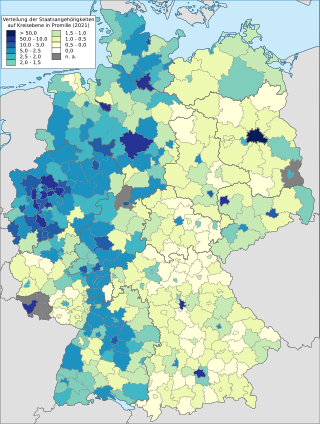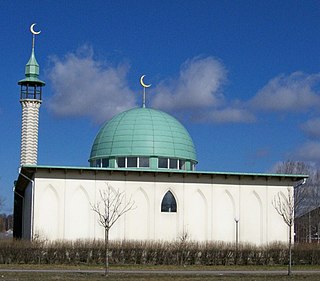
The Jewish exodus from the Muslim world was the migration, departure, flight and expulsion of around 900,000 Jews from Arab countries and Iran, mainly from 1948 to the early 1970s, though with one final exodus from Iran in 1979–80 following the Iranian Revolution. An estimated 650,000 of the departees settled in Israel.

The Arab world, formally the Arab homeland, also known as the Arab nation, the Arabsphere, or the Arab states, comprises a vast group of countries, mainly located in Western Asia and Northern Africa. While the majority of people in the Arab world are ethnically Arab, there are also significant populations of other ethnic groups such as Berbers, Kurds, Somalis and Nubians, among other groups. Arabic is used as the lingua franca throughout the Arab world.

Arab diaspora is a term that refers to descendants of the Arab emigrants who, voluntarily or as forcibly, migrated from their native lands to non-Arab countries, primarily in the Americas, Europe, Southeast Asia, and West Africa.

The phenomenon of large-scale migration of Christians is the main reason why Christians' share of the population has been declining in many countries. Many Muslim countries have witnessed disproportionately high emigration rates among their Christian minorities for several generations. Today, most Middle Eastern people in the United States are Christians, and the majority of Arabs living outside the Arab World are Arab Christians.
Arab Canadians come from all of the countries of the Arab world. According to the 2021 Census, there were 690,000 Canadians, or 1.9%, who claimed Arab ancestry. According to the 2011 census there were 380,620 Canadians who claimed full or partial ancestry from an Arabic-speaking country. The large majority of the Canadians of Arab origin population live in either Ontario or Quebec.

The Middle East and North Africa is a geographic region whose countries are often referred to by the acronym MENA. It is also known as WANA, SWANA, or NAWA, which alternatively refers to the Middle East as West Asia or as Southwest Asia; this is another way to reference the geographical region, instead of using the more common political terminology.

Domari is an endangered Indo-Aryan language, spoken by Dom people scattered across the Middle East and North Africa. The language is reported to be spoken as far north as Azerbaijan and as far south as central Sudan, in Turkey, Iran, Iraq, Palestine, Israel, Jordan, Egypt, Sudan, Libya, Tunisia, Algeria, Morocco, Syria and Lebanon. Based on the systematicity of sound changes, it is known with a fair degree of certainty that the names Domari and Romani derive from the Indo-Aryan word ḍom. Although they are both Central Indo-Aryan languages, Domari and Romani do not derive from the same immediate ancestor. The Arabs referred to them as Nawar as they were a nomadic people that originally immigrated to the Middle East from the Indian subcontinent.

Waleed, also spelt as Walid, Oualid, or Velid, is an Arabic-language masculine given name meaning newborn child.
Arabs in Bulgaria are the people from Arab countries, particularly Lebanon, Syria, the Palestinian Territories, Iraq, and Jordan and also small groups from Egypt, Algeria, Tunisia, Morocco, Libya and Sudan, who emigrated from their native nations and currently reside in Bulgaria. In the over forty-year history of this community, 11,400 Arabs have migrated to Bulgaria. According to other data from two teams of anthropologists and sociologists, the number of Arabs in Bulgaria who are legal residents and officially have work permits was 17,000 in 2004.
Arabs in Europe are people of Arab descent living in Europe today and over the centuries. Several million Arabs are residents in Europe. The vast majority form part of what is sometimes called the "Arab diaspora", i.e. ethnic Arabs or people descended from such living outside the Arab World. Most of the Arabs in Europe today are from the Maghreb.

Arab Germans, also referred to as German Arabs or Arabic Germans, are ethnic Arabs living in Germany. They form the second-largest predominantly Muslim immigrant group in Germany after the large Turkish German community.
Arabs in Romania are people from Arab countries who live in Romania. The first Fellah settlers came in 1831 - 1833 from Ottoman Syria to Dobruja. They assimilated in the Turkish-Tatarian Population. Some of them came to Romania during the Ceaușescu era, when many Arab students were granted scholarships to study in Romanian universities. Most of them were Lebanese, Syrians, Palestinians, Iraqis, Libyans, Egyptians, and Jordanians. Most of these students returned to their countries of origin, but some remained in Romania starting families here. It is estimated that almost half a million Middle Eastern Arabs studied in Romania during the 1980s. A new wave of Arab immigration started after the Romanian Revolution. Many of the newly arrived Arabs came to Romania in the 1990s in order to develop businesses. In addition, Romania has people from Arab countries who have the status of refugees or illegal immigrants, primarily from North Africa, trying to immigrate to Western Europe. In particular, the European migrant crisis lead to Syrian people coming to Romania, although many Syrians were already living in Romania at the time of the crisis.

Arabs in Sweden are citizens and residents of Sweden who emigrated from nations in the Arab world. They represent 5.3% of the total population of the country. About a quarter of Arabs in Sweden are Christians.
Arabs in Serbia are mostly expatriates from a range of Arab countries, particularly Libya, Lebanon, Syria, Palestine, Iraq, and Jordan; and also small groups from Egypt, Algeria, Tunisia, Morocco, and Sudan. Lebanese and Syrian citizens were the first Arabs to arrive in modern Serbia. In the 1970s and 1980s, many students from Iraq and Syria were enrolled at the University of Belgrade. More recently, as a result of the Arab Spring and the Syrian Civil War, large numbers of Arabs are transiting Serbia as refugees, trying to immigrate to Western Europe.
Arabs in Austria are Austrians of Arab ethnic, particularly Lebanon, Syria, Palestinian, Iraq, Jordan and also small groups from Egypt, Algeria, Tunisia, Morocco, Libya, Yemen and Sudan, who emigrated from their native nations and currently reside in Austria. Most Arab Austrians are of Iraqis and Lebanese or Syrian origin, as a result of the fact that they were the first Arabs to arrive in Austria.
Arab New Zealanders refers to people from Arab countries, particularly Lebanon, Syria, Palestine, Iraq, and Jordan and also small groups from Egypt, Algeria, Tunisia, Morocco, Libya, Yemen and Sudan, who emigrated from their native nations and currently reside in New Zealand. The term also refers to descendants of diasporic Arabians such as descendants of Arab merchants to Asian nations, whose ancestral origins may be traced to merchants hailing from the Southern Arabian nations such as Yemen and Oman and the Arab nations of the Persian gulf region. Most Arab New Zealanders are of Lebanese and Iraqi descent because they were the first Arabs to arrive in New Zealand. Therefore, an Arab New Zealander is a New Zealander of Arab cultural and linguistic heritage or identity whose ancestry traces back to any of various waves of immigrants originating from one or more of the twenty countries comprised by the Arab world.
Arabs in Denmark are Danish permanent residents originating from Arab countries. The largest subpopulations found hail from Lebanon, Syria, Iraq, Palestine, and Morocco followed by smaller groups from other of the 21 Arab League countries.

In the narrow sense, Lebanese people in Germany include migrants from Lebanon living in Germany and their descendants, excluding Palestinians.
There have been Arabs in Spain since the early 8th century when the Umayyad conquest of the Iberian Peninsula created the state of Al-Andalus. In modern times there are expatriates from a range of Arab countries, particularly Morocco, Algeria, Lebanon, Syria, the Palestinian Territories, and Iraq; and also small groups from Egypt, Tunisia, Libya, Jordan and Sudan. As a result of the Arab Spring, many have the status of refugees or illegal immigrants, trying to immigrate especially to France, Germany and Sweden. The Arab population in Spain is estimated to be between 702,000 and 1,600,000 - 1,800,000.
Arabs in Switzerland are Swiss citizens or residents of Arab ethnic, cultural and linguistic heritage from Arab countries, particularly Morocco, Tunisia, Algeria, Lebanon, Syria, Iraq and Egypt, also small groups from Palestine, Yemen, Libya, Jordan and Sudan, who emigrated from their native nations and currently reside in Switzerland.









